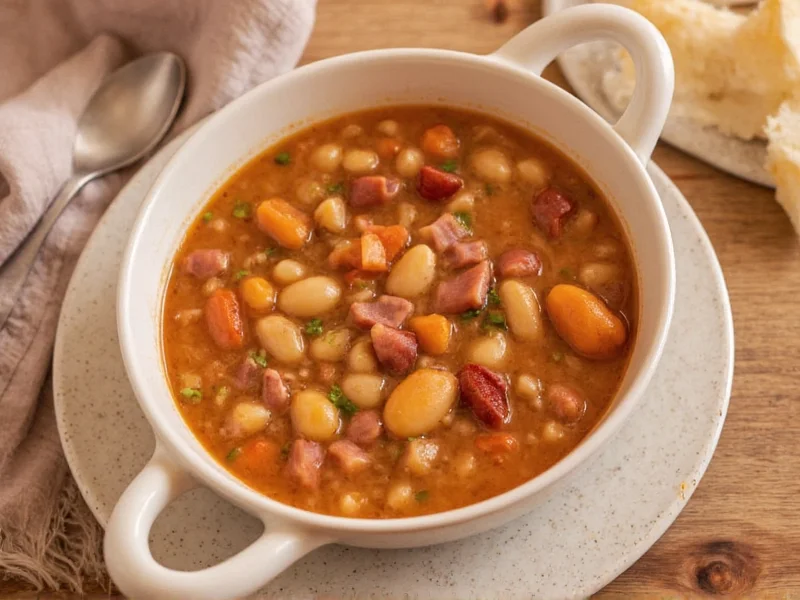Originating from New England culinary traditions, ham bean soup has evolved into a beloved staple across American households. Its enduring popularity stems from both its nutritional benefits and remarkable versatility. Whether using a ham bone from Sunday dinner or starting from scratch with smoked ham hock, this soup transforms simple pantry ingredients into a deeply flavorful meal that satisfies both hunger and soul.
The Essential Components of Authentic Ham Bean Soup
Creating exceptional ham bean soup requires understanding its foundational elements. The magic happens when quality ingredients work together through slow simmering. Unlike quick-fix versions, traditional preparation develops complex flavors that instant mixes can't replicate.
Key Ingredients and Their Roles
Understanding each component's purpose elevates your soup from ordinary to extraordinary. Navy beans remain the classic choice for their creamy texture when cooked, though great northern or cannellini beans work beautifully for creamy ham and white bean soup variations. The ham element—whether bone-in ham hock, smoked ham shank, or leftover baked ham—provides the essential smoky depth that defines this dish.
Aromatic vegetables form the flavor base: onions, carrots, and celery in the traditional mirepoix ratio. Bay leaves, thyme, and black pepper contribute subtle complexity without overpowering. Many home cooks debate whether tomatoes belong in authentic traditional New England ham bean soup, with purists omitting them while others appreciate the slight acidity they provide.
| Bean Type | Cooking Time | Texture Profile | Best For |
|---|---|---|---|
| Navy Beans | 60-90 minutes | Creamy, breaks down slightly | Classic New England style |
| Great Northern | 75-100 minutes | Firm yet creamy | Creamy variations |
| Cannellini | 70-95 minutes | Buttery, holds shape | White bean soup versions |
| Split Peas | 45-60 minutes | Breaks down completely | Thicker, heartier texture |
Step-by-Step Preparation Guide
For the best beans for ham soup, start by sorting and rinsing dried beans to remove any debris. Soaking overnight reduces cooking time and improves digestibility, though the quick-soak method works well when time is limited. Place soaked beans in a large pot with fresh water, bringing to a gentle boil before reducing to a simmer.
Add your ham element—bone-in cuts provide superior flavor—and aromatics. Skim foam during the first 15 minutes for a clearer broth. Simmer uncovered for 60-90 minutes until beans reach tender perfection. Remove meat, shred the edible portions, and return to the pot. Season carefully at the end, as ham contributes significant saltiness.
Professional Cooking Techniques
Master chefs emphasize several ham bean soup cooking tips that transform good soup into exceptional. The "holy trinity" of mirepoix should be finely diced for even flavor distribution. Adding a strip of kombu seaweed during cooking enhances umami while improving bean digestibility. For depth of flavor, sauté vegetables separately before adding to the soup.
Acidity balances richness—add a splash of apple cider vinegar or sherry near the end of cooking. For thicker texture without cream, mash some beans against the pot side. Remember that soup flavors deepen overnight, making leftover ham soup ideas particularly valuable for meal planning.
Variations for Every Kitchen
Adapt this versatile recipe to your equipment and preferences. For slow cooker ham bean soup, combine all ingredients except delicate herbs and cook on low for 6-8 hours. Instant Pot versions reduce cooking time to 30 minutes under pressure while maintaining flavor integrity.
Dietary adaptations work beautifully: use turkey ham for lower sodium, add kale or spinach for extra nutrition, or incorporate fire-roasted tomatoes for southwestern flair. Vegetarian versions substitute smoked paprika and liquid smoke for ham's distinctive flavor, though they lack the authentic profile of healthy ham and bean soup.
Serving and Storage Guidelines
Serve piping hot with crusty bread for dipping. A sprinkle of fresh parsley or chives adds color contrast. For optimal food safety, cool soup rapidly before refrigerating. Properly stored in airtight containers, it maintains quality for 4-5 days in the refrigerator or up to 6 months frozen.
When reheating, add broth or water as needed since beans continue absorbing liquid during storage. Each reheating cycle enhances flavor complexity, making ham bean soup leftovers often superior to the initial serving—a rare quality among prepared foods.
Frequently Asked Questions
Can I make ham bean soup without soaking the beans overnight?
Yes, you can use the quick-soak method: cover beans with water, bring to boil for 2-3 minutes, then remove from heat, cover, and let stand for 1 hour. Alternatively, pressure cookers significantly reduce cooking time for unsoaked beans, though soaking generally yields more consistent texture.
How can I reduce the salt content in ham bean soup?
Choose low-sodium ham products, rinse beans thoroughly after soaking, and limit added salt during cooking. You can also use less ham initially and supplement flavor with smoked paprika or a small piece of kombu seaweed, which adds umami without sodium.
What's the best way to thicken ham bean soup?
For natural thickening without altering flavor, mash some cooked beans against the side of the pot and stir back into the soup. Alternatively, remove 1-2 cups of soup, blend until smooth, then return to the pot. Avoid flour-based thickeners which can create an unpleasant texture in bean soups.
Can I freeze ham bean soup successfully?
Absolutely. Cool the soup completely, then store in airtight containers with at least 1 inch of headspace for expansion. Properly frozen, it maintains quality for 4-6 months. Thaw overnight in the refrigerator before reheating, adding broth if needed as beans absorb liquid during storage.
Why does my ham bean soup cause digestive discomfort?
Dried beans contain oligosaccharides that some people find difficult to digest. Soaking beans thoroughly, changing the soaking water, and discarding the initial cooking water can reduce these compounds. Adding kombu seaweed during cooking or using an over-the-counter enzyme supplement may also help improve digestibility.











 浙公网安备
33010002000092号
浙公网安备
33010002000092号 浙B2-20120091-4
浙B2-20120091-4